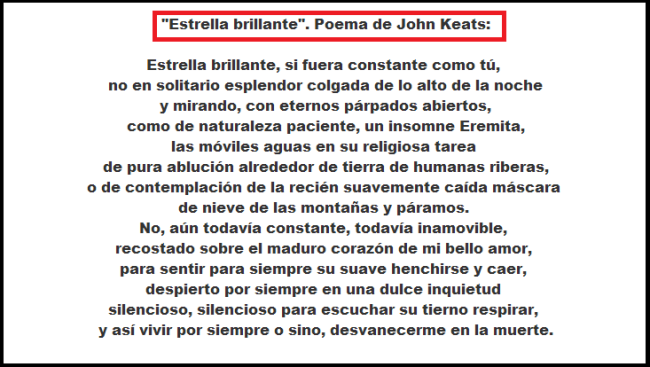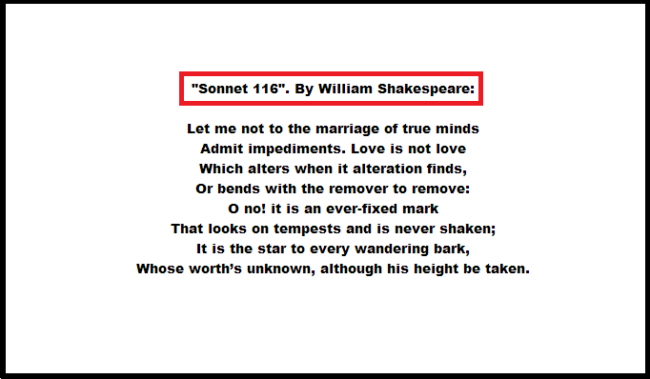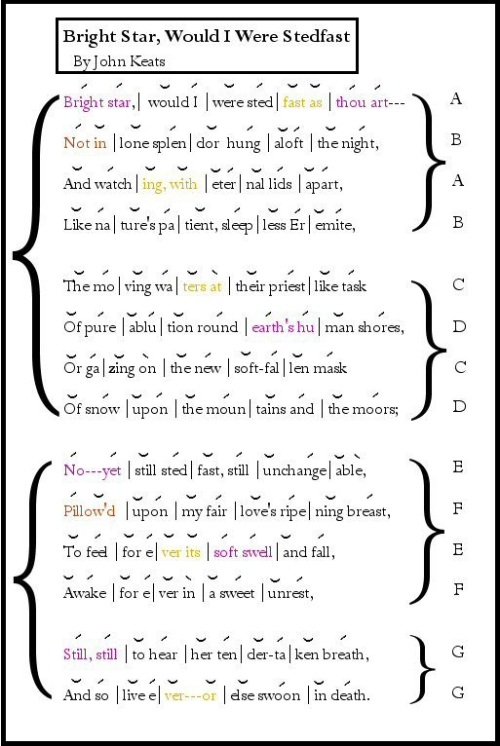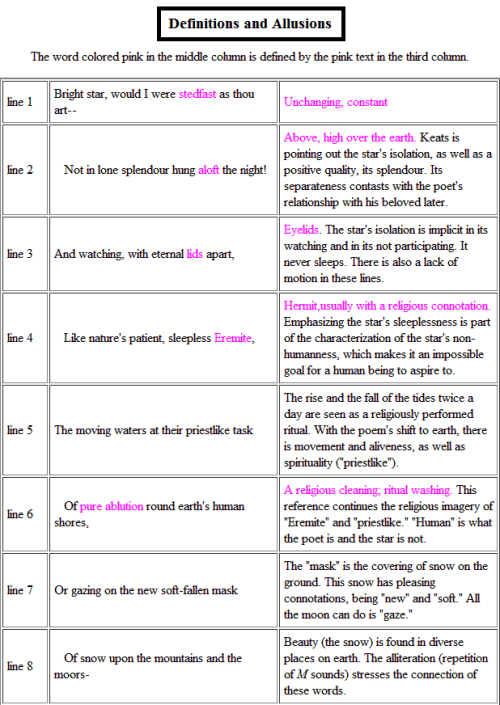♠Poetry / Poesía:
William Shakespeare: “Sonnet CXVI” / “Soneto CXVI”:
____________________________________________________________________________________________________________________________
♠Poesía: William Shakespeare: “Soneto CXVI”:
___________________________________________________________________________________________________________________________
♠William Shakespeare: “Sonnet 116”:
_____________________________________________________________________________________________________________________
♠William Shakespeare: “Sonnet 116”: “Let me not to the marriage of true minds”:
_____________________________________________________________________________________________________________________
♠William Shakespeare´s Sonnet 116:
“Summary & Analysis”:
Shakespeare´s Sonnet 116 was first published in 1609. Its structure and form are a typical example of the Shakespearean Sonnet
The poet begins by stating he should not stand in the way of true love. Love cannot be true if it changes for any reason. Love is supposed to be constant, through any difficulties. In the sixth line, a nautical reference is made, alluding that love is much like the north star to sailors. Love should also not fade with time; instead, true love lasts forever.
The poet makes his point clear from line 1: true love always perseveres, despite any obstacles that may arise. He goes on to define love by what it doesn’t do, claiming that it stays constant, even though people and circumstances may change. Love never dies, even when someone tries to destroy it. Rather than being something that comes and goes, love is eternal and unchanging – so much so that the poet compares it to the North Star, which never moves in the sky and guides lost ships home. This metaphorical star is mysterious and perhaps incomprehensible, even though we can chart its location.
Moving on to a new image, love isn’t at the beck and call of time (or time’s consequences, age and death); mortality isn’t an issue for true love, which doesn’t fade even when youth and beauty disappear. Love doesn’t change as the days go by; rather, it remains strong until the lover’s dying day (or beyond…chew on that for a while).
Finally, the poet stakes his own reputation on this definition, boldly claiming that if anyone can prove him wrong, he’ll eat his words. That is to say, if this idea of love turns out to be wrong, then he’ll take back everything he wrote and it’ll be as though it never existed. Furthermore, if this specific portrayal of love is somehow proved to be the wrong one, then nobody, as far as the poet is concerned, has ever loved at all.
Along with Sonnets 18 (“Shall I compare thee to a summer’s day?”) and 130 (“My mistress’ eyes are nothing like the sun”), Sonnet 116 is one of the most famous poems in the entire sequence. The definition of love that it provides is among the most often quoted and anthologized in the poetic canon. Essentially, this sonnet presents the extreme ideal of romantic love: it never changes, it never fades, it outlasts death and admits no flaw. What is more, it insists that this ideal is the only love that can be called “true”—if love is mortal, changing, or impermanent, the speaker writes, then no man ever loved.
In the first quatrain Shakespeare uses repetition of the words “love” and “love” (line 2), “alters” and “alteration” (line 3) and “remover” and “remove” (line 4) to create a feeling of constancy and strength. This complements his allusion to the marriage ceremony in line one. (Grimes, 2007)
The second quatrain uses two metaphors to describe love, both concerned with light, navigation and the sea.
The first metaphor compares love to “an ever-fixed mark” such as a lighthouse, used by sailors during bad weather to avoid peril.
The second compares love to a star, a light in the heavens which can be used to navigate by, but “whose worth’s unknown”. This second image is the most interesting for how many decisions are made on a daily basis in the name of an emotion that is not really understood.
The second quatrain explains how love is unchanging. According to Neely, “Love is a star, remote, immovable, self-contained, and perhaps, like the ‘lords and owners of their faces,’ improbably and even somewhat unpleasantly cold and distant.” The second quatrain continues Shakespeare’s attempt to define love, but in a more direct way
Shakespeare mentions “it” in the second quatrain according to Douglas Trevor, “The constancy of love in sonnet 116, the “it” of line five of the poem, is also – for the poet – the poetry, the object of love itself.” Not only is there a direct address to love itself, the style Shakespeare’s contemplation becomes more direct. Erne states, “Lines five to eight stand in contrast to their adjacent quatrains, and they have their special importance by saying what love is rather than what it is not.” This represents a change in Shakespeare’s view that love is completely undefinable. This concept of unchanging love is focused in the statement, “love is an ever-fixed mark’.
The first two lines of quatrain three (lines 9 – 10) tell us that although physical beauty, “rosy lips and cheeks”, may fade and die, love is not affected by time. This sentence is interesting for a few reasons. Firstly Time is personified by referring to it as “him” but it is also compared to Death, always a close relative anyway, by giving “him” a “bending sickle”, the Grim Reapers scythe.
The last two lines of quatrain three (11-12) sum up the point of the whole poem: love doesn’t change over time. It endures the passing of time, which is depicted as fleeting and “brief,” and lasts until “the edge of doom,” otherwise known as Judgment Day, the end of time, or whatever you want to call it.
The final two lines of the sonnet (couplet) provide a dramatic and quite bold closing statement.
Line 13 uses rather legalistic language to basically say, “If these ideas are wrong and anyone can prove that I’m incorrect…”
The final line resolves this challenge through a somewhat complicated twist; by saying that the poet has never written anything and that nobody has ever really been in love before if love actually turns out to be less than eternal, the poem’s truth immediately becomes impossible to dispute.
As Linda Gregerson highlights in her article on Shakespeare´s “Sonnet 116”:
“The couplet represents a last, desperate attempt to regain control. It rests upon a sort of buried syllogism: I am obviously a writer (witness this poem); I assert that love is constant; therefore love must be constant. As any logician could testify, however, these premises have no necessary relationship to their conclusion. The couplet is designed to shut down all opposition, to secure the thing (unchanging love) the poem has staked its heart on. It is sheer bravado, and of course it fails. What fails as logical proof, however, succeeds quite brilliantly as poetry”.
______________________________________________________________________________________________________________________________
“Shakespeare´s Sonnet 116”: “Slideshare”:
____________________________________________________________________________________________________________________________
________________________________________________________________________________________________________________________
_______________________________________________________________________________________________________________________________
Links Post:
http://en.wikipedia.org/wiki/Sonnet_116
http://www.shmoop.com/sonnet-116/summary.html
http://www.shakespeares-sonnets.com/sonnet/116
http://www.sparknotes.com/shakespeare/shakesonnets/section7.rhtml
http://www.theatlantic.com/past/docs/unbound/poetry/soundings/shakespeare.htm
http://barraoc.hubpages.com/hub/Sonnet-116-by-William-Shakespeare-An-Analysis
https://aquileana.wordpress.com/2013/10/15/poetry-william-shakespeare-soneto-xviii-sonnet-xviii/
http://www.shakespeares-sonnets.com/sonnet/130
_______________________________________________________________________________________________________________________________


















